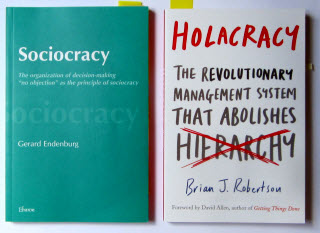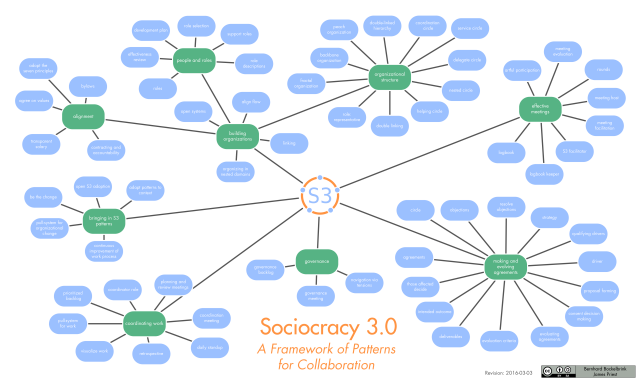Sociocracy is a governance method based on consent decision-making and cybernetic principles which was developed during the 1970s. Sociocracy significantly influenced the early development of Holacracy in 2006/2007. And Sociocracy 3.0 was introduced in 2014. Here’s my attempt to compare all three based on my reading of Gerard Endenburg’s first book on Sociocracy, Brian Robertson’s new book on Holacracy, and Bernhard Bockelbrink’s and James Priest’s freely available Introduction to Sociocracy 3.0, (v2015-04-23).

|
Sociocracy |
Holacracy |
Sociocracy 3.0 |
|
| Aims | To enable everyone to develop as far and in as diversified a manner as possible.1 | To harness the tremendous sensing power of the human consciousness available to our organizations.8 | To make the best use of the talent already present and help the organization move forward (grow) in its own pace through continuous improvement.15 |
| People | It is fundamentally important to involve the complete individual in the decision-making process.2 | Differentiates between role and soul in order to keep the organization from being overly influenced by individual feelings and opinions that are not relevant to work.9 | People gather around drivers, co-create policies, and act as sensors (nerve endings) for the organization.16 |
| Equivalence | Equivalence in policy decision-making, and in the potential for existence and development.3 | Not mentioned.10 | Everyone affected by a decision has the power to withdraw consent.17 |
| Organization | An organization exists for the people and it is in their interest that the actual problem-solving capability of their organization is as great as possible.4 | An organization is an entity that exists beyond the people, with its own purpose to enact and with work to do beyond just serving the people doing that work.11 | An organization is defined by its values, driver and strategy.18 |
| Needs | To give both the individual and the group space to arrange their lives in accordance with their own wishes and needs.5 | To fulfill the organization’s purpose – not people’s desires and needs.12 | To identify needs in relation to the organization itself, its members, stakeholders, customers or environment.19 |
| Rules | Rules are laid down to allow each individual to perform within limits. Equal say of each participant is guaranteed in determining the operating limits, or “thresholds“.6 | Explicit roles with explicit accountabilities creates clarity on the operating limits.13 | Policies within defined domains of accountability guide the flow of value.20 Policies are created to satisfy drivers.21 Core principles are values.22 Values are policy.23 Everyone needs to become an expert in policy.24 |
| Empowerment | Ensures that each system component, for example an individual, is empowered to issue its own instructions by consent.7 | Establishes a core authority structure and a system that empowers everyone.14 | Manages expectations via (self-)accountability. Accountability is a core principle.25 Collaboration happens within circles and follows principles and values.26 |
Update 2016-07-09:
Bernhard Bockelbrink and James Priest have updated their Introduction to Sociocracy 3.0, from (v2015-04-23) to (v2016-01-29), since I wrote this post 2015-11-28. Policies are now called agreements in Sociocracy 3.0.27 Maybe this is an attempt to change the language in Sociocracy 3.0? Here is a post on the difference between the language of rules & polices vs. the language of agreements. Like sociocracy and Holacracy, Sociocracy 3.0 still emphasizes that structure (rules, policies, agreements, or whatever you call it) guides the flow.28 Here is an example of when structure instead follows the flow.
Update 2016-10-06:
James Priest writes in a comment on this post that it’s a “much more accurate description” to say that structure follows flow in Sociocracy 3.0, since Sociocracy 3.0 ”invites, facilitates and supports” optional and adaptable patterns. Here is James Priest’s comment. Here is my comment, and here is James Priest’s answer.
A constant challenge in comparing Sociocracy 3.0 with sociocracy and Holacracy is the constant change. An example, as already mentioned, is policies in Sociocracy 3.0 (v2015-04-23), which were changed to agreements in Sociocracy 3.0 (v2016-01-29).29 An agreement is designed to guide the flow of value.30

Another example is patterns, which have grown into a framework in Sociocracy 3.0 during the year. A pattern is an agreement,31 and a template for successfully navigating a specific context.32 Sociocracy 3.0 is now said to form a pattern language,33 and has more than 60 patterns.34 The term pattern language was coined by Christopher Alexander. Here is a presentation by Christopher Alexander on patterns in architecture. And here is my analysis of Alexander’s pattern language.

Notes:
1 Gerard Endenburg, Sociocracy: The organization of decision-making, (Eburon, 1998), p. 5.
2 Ibid..
3 Ibid., p. 167.
4 Ibid., p. 142.
5 Ibid., p. 10.
6 Ibid., pp. 23, 145.
7 Ibid., p. 22.
8 Brian Robertson, Holacracy: The Revolutionary Management System that Abolished Hierarchy, (Penguin, 2015), p. 7.
9 Ibid., pp. 42—46, 116.
10 Ibid., no quote on equivalence found.
11 Ibid., p. 148.
12 Ibid., p. 198.
13 Ibid., p. 41.
14 Ibid., p. 21.
15 Bernhard Bockelbring and James Priest, Introduction to Sociocracy 3.0, (v2015-04-23), pp. 5—7 (accessed 2015-11-28).
16 Ibid., pp. 56, 78, 82.
17 Ibid., p. 30.
18 Ibid., p. 186.
19 Ibid., p. 43.
20 Ibid., pp. 47, 49, 51.
21 Ibid., p. 48.
22 Ibid., p. 25.
23 Ibid., p. 182.
24 Ibid., p. 133.
25 Ibid., p. 33.
26 Ibid., pp. 57, 184.
27 Bernhard Bockelbring and James Priest, Introduction to Sociocracy 3.0, (v2016-01-29), pp. 46—47 (accessed 2016-07-09).
28 Ibid., pp. 46, 118.
29 Ibid., p. 47.
30 “An agreement is an agreed upon guideline, pattern, process or protocol designed to guide the flow of value.” See Bernhard Bockelbring & James Priest, Sociocracy 3.0 Handbook (beta), (2016-09-14), p. 16 (accessed 2016-10-06).
31 Ibid. (accessed 2016-10-06).
32 “A pattern is a template for successfully navigating a specific context.” Ibid., p. 13 (accessed 2016-10-06).
33 “The patterns in S3 form a pattern language, i.e. while each pattern can be applied independently, patterns mutually reinforce each other, because they are all based on the same set of principles.” Ibid., p. 3 (accessed 2016-10-06).
34 Bernhard Bockelbring & James Priest, Sociocracy 3.0 – All Patterns in one Big Picture, (2016-06-22) (accessed 2016-10-06).
Related posts:
Holacracy vs. Sociocracy
Book Review: Sociocracy
Book Review: Holacracy
Language of rules & policies vs. agreements
Analysis of Sociocracy and Holacracy
Leave a Reply
You must be logged in to post a comment.